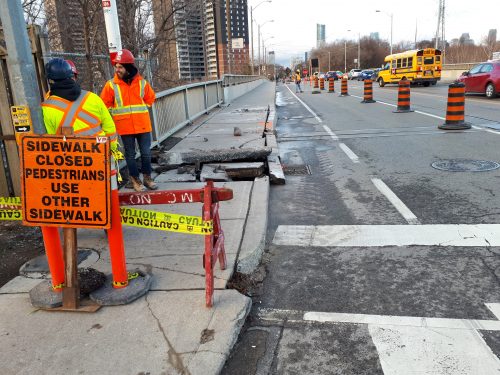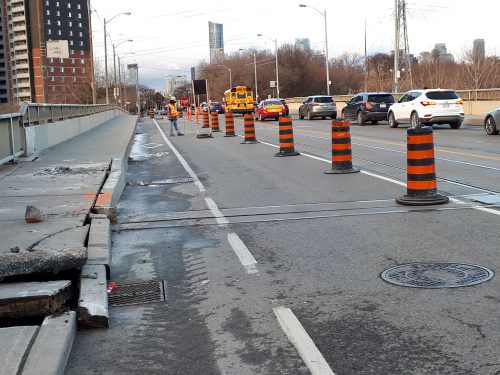
A ‘utility cut’ is an area of sidewalk or road that was cut out (excavated) to improve, install or remove a piece of watermain, gas main, power line or telecommunications infrastructure. When utility companies perform work that requires this type of excavation, they are required to return the area to its original condition.
Utility cuts are typically completed in two stages. The first stage involves the utility company performing work to their infrastructure and then temporarily repairing the surface area with asphalt. This temporary asphalt ensures that pavement surface is level and safe until permanent repairs can be completed. Then utilities engage a contractor to perform permanent restorations of the city infrastructure impacted by their cuts which includes replacement of roads, curbs, sidewalks and soft surfaces.
If you are a City of Toronto approved utility company and want to undertake any construction work within the public right of way, you will be required to fill out a utility cut permit application prior to starting work.


The City is committed to keep infrastructure in a state of good repair at a minimal cost. Toronto uses a cost-effective way of maintaining City infrastructure called “life-cycle costing.” Repairing roads, sidewalks, bridges, and expressways as necessary. This avoids costly maintenance in the future. It also extends the life of infrastructure before it would need reconstruction. This practice is applied to roads, sidewalks, bridges and expressways.
The City’s roadways are an asphalt top and a concrete bottom. In most cases, a new road’s asphalt has a life span of 18-25 years. Cracks and holes appear in the road as weather conditions and regular wear-and-tear occur, then City staff repair them. When water enters the cracks created in the road, it can lift chunks of the asphalt.
When a road has existed for about 20 years, inspectors look at the road and perform engineering tests to determine if it needs a new surface. If deemed to be in good shape, there is no work done on the road and inspectors return at a later date to re-inspect the road. If the asphalt is in disrepair, the City will plan road resurfacing work, which involves replacing the asphalt surface.
If preventative measures, such as resurfacing, are periodically done, the concrete base of the road will last about 50 years. If preventative measures are not undertaken, a road’s base might last only 25-30 years. When inspecting the road, inspectors consider the condition of the road base to keep track of the need for a full road reconstruction.
Taking steps to repave the road before it reaches a state of further disrepair has some obvious benefits. The work results in an improved road surface. That benefits road users and also keeps the road base in a state of good repair.
When inspectors are looking at the road conditions, they also inspect sidewalks and sidewalk bays. Inspectors will track the condition of the sidewalk and note which sections need repair or replacement. This means replacement only happens to the bays in the greatest need. Replacement will happen when road work is already planned or on an as-needed basis.
Report minor sidewalk or road damage online.